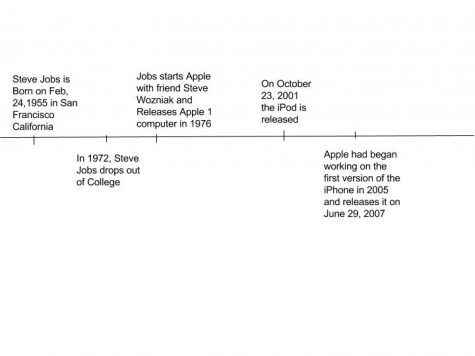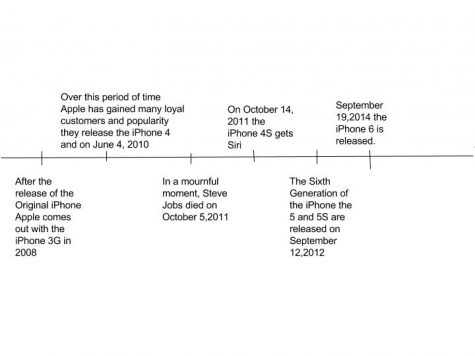iPhone Over the Years
Apple’s Signature Invention Prepares for its Tenth Anniversary
The iPhone has become a staple item for people all over the world after its introduction to the market on June, 29, 2007. Over the years, the iPhone has increased in price, but along with it the state-of-the-art technology and usage has also increased. However, what exactly is it that pushes the iPhone to the top? What features will be included into future iPhone’s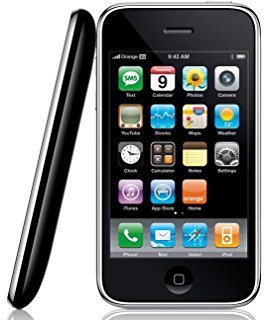 , and how will it differ from the previous versions?
, and how will it differ from the previous versions?
Apple’s Success
One of the main factors that contribute to Apple’s success is that in the modern national market, the iPhone and other Apple products have shown dominance. Samsung is Apple’s most well-known competitor running an Android OS, and Google-created phones also control a small portion of the phone market.
The key to sales and profit is reliability. If the product or company is well-known for being reliable, then customers will flock to stores time and time again to purchase new generations of products, but if trust between the company and the consumer is broken it can lead to many problems. An example of this is the Samsung Note 7 fiasco, where the Note 7 had a tendency to blow up while charging. Apple has never had problems like this for its iPhones, so it has retained its status as a dominant member of the phone, tablet, and watch market.
Apple has also stayed at least two years ahead of its competitors, by creating and innovating inventions much before their release. For example, the new iPhone, which is going to be released in October of 2017, has been in the design process for over two years. Similarly, the iPad will most likely be out next March, and has also been in construction for over two years.This way
Apple customers know that when they buy and use Apple products, they have been tested and perfectly made. Steve Jobs, the creator of the iPhone, had visible foresight, for he is quoted as saying “Design is not just what it looks like and feels like. Design is how it works.”. Another quote is “Innovation distinguishes between a leader and a follower.”
iPhone’s Influence
The iPhone that came out in 2007 brought a tidal wave of change throughout the technology industry and the world. For example, people began ditching physical keyboards and switching to the added in keyboard, making the form much thinner. Apple built a music player app, called iTunes, into the iPhone, which made listening to music on phones became common. The iPhone also didn’t require a stylus pen, and it had an elegant touch screen that pleased many users. This was something that had only been imaginable in science fiction up to that point. Thanks to the iPhone, gaming markets are soaring because gamers and developers started to use the iPhone. All of this results in the iPhone being one of the most influential and important gadgets ever, changing the perspective on phones and the way smartphones function today.
Changes to the iPhone
The first iPhone to be released was called the first generation iPhone. This phone only provided voice signals. However, what distinguished it among other phones was the technological development which was capable of transferring calls from one site to the next as the user traveled between cells during a conversation.
Afterwards, the 2G had an obsolete screen size of around 3.5” and had a terrible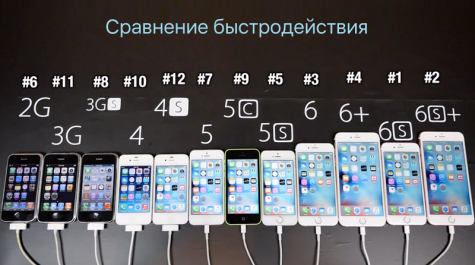 e picture quality of 380 X 480 pixels. With only a 52 percent screen to body ratio the original iPhone was terrible compared to today’s standards. The successor to the 2G, the 3G, had the same screen size and resolution as the 2G but included features as enhanced Gorilla Glass (A type of tempered glass that withstands pressure and damage) for protection and had coatings to enhance feel. After the 3G came the 3GS which included the same specifications as the 3G except for the fact that it that it had double the storage at 32GB. It was viewed as a minor disappointment, but it also possessed faster performance, a better camera, extra storage, and a voice control preceding Siri.
e picture quality of 380 X 480 pixels. With only a 52 percent screen to body ratio the original iPhone was terrible compared to today’s standards. The successor to the 2G, the 3G, had the same screen size and resolution as the 2G but included features as enhanced Gorilla Glass (A type of tempered glass that withstands pressure and damage) for protection and had coatings to enhance feel. After the 3G came the 3GS which included the same specifications as the 3G except for the fact that it that it had double the storage at 32GB. It was viewed as a minor disappointment, but it also possessed faster performance, a better camera, extra storage, and a voice control preceding Siri.
The successor to the 3GS was named the iPhone 4 which had a slightly higher battery capacity, a new iOS, Siri, and finally had an improved resolution at 640 X 960. The 4S had double the storage (64 GB) of the 4 and all of its specifications.
Then came the iPhone 5. It had many new specifications, like a screen of 0.5 inches bigger, and a resolution which is respectable even to today’s standards at 1136 X 640. The iPhone 5 caused a huge rise in the revenue at around 60 billion dollars in the span of 2 years. The iPhone 5C was Apple’s first colorful phone. It ca me in many colors like blue, green, yellow, white, and pink. It was also cheaper t
me in many colors like blue, green, yellow, white, and pink. It was also cheaper t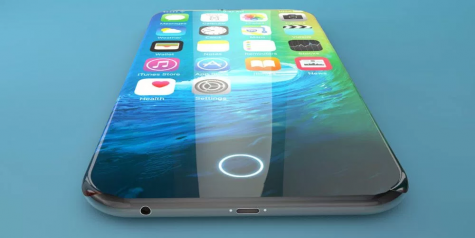 han the other models, because the back was made of plastic. Following the the 5 generation came the iPhone 6, 6+, 6S and the 6S+. These phones include a A9 processor and a much larger screens that go up to sizes as much as 5.5”. They also come with features like a fingerprint scanner. They have a similar design to the iPhone 7. There are a few differences between the iPhone 6 and the 6S
han the other models, because the back was made of plastic. Following the the 5 generation came the iPhone 6, 6+, 6S and the 6S+. These phones include a A9 processor and a much larger screens that go up to sizes as much as 5.5”. They also come with features like a fingerprint scanner. They have a similar design to the iPhone 7. There are a few differences between the iPhone 6 and the 6S
The iPhone 7 and the 7 Plus were released on September 16th, 2016. The iPhone’s are running the A10 processor, an upgrade from the A9 processor used in the iPhone 6S. The major differences are the lack of the headphone jack, the taptic engine, the new and improved camera, and water resistance. Apple decided to get rid of the home button and the headphone jack in order create the IP67 water resistance. It now has a taptic engine to simulate the feel of pressing a home button. The difference between the iPhone 7 and the 7 Plus is that the Plus has a significantly bigger display and has a dual lens camera. With these apparent benefits, the 3.5 millimeter audio jack disappears. Not to mention, it still has no wireless charging nor fa st charging. This recent smartphone has a LED display still at 750p. There is still no USB-C nor expandable storage. Most importantly, there is no amazing factor that makes the iPhone 7 wow the public. Many say that frankly, the tedious and horrible iPhone 7 is an absolute excuse for Apple.
st charging. This recent smartphone has a LED display still at 750p. There is still no USB-C nor expandable storage. Most importantly, there is no amazing factor that makes the iPhone 7 wow the public. Many say that frankly, the tedious and horrible iPhone 7 is an absolute excuse for Apple.
Future iPhones
With the success of previous iPhones, many users are excited for future releases. This year is the tenth anniversary for the iPhone, and it brings many speculations and rumors of the next product. The hopes are very high for its next model. The expectations are that the iPhone 8 will be released in September, 2017. Apple has deliberately decided to leave out a lot of features. It is rumored that they want to make their next flagship (the company’s latest and greatest) very special because 2018 would be the 10th anniversary for the iPhone. Apple is also rumored to add wireless charging, virtual reality compatibility, and a display covering much of the phone by removing the bezels.
The latest creations of these smartphones, the iPhone 7 and the iPhone 7 Plus, were all revealed in Autumn, 2016. Usually, Apple releases their phones in September, but there are whispers of a delay from its usual legacy. Some expected features of the new release are a glass body, wireless charging, edge to edge display, camera and Touch ID integrated into the display, faster A11 processor, no home button, and more. The camera may have 3D sensing capabilities and dual lenses. This new iPhone is supposed to have an all curved screen to maximize screen space. The New iPhones are getting increasingly more expensive, for example, the iPhone 8 is predicted to be $1000 while the iPhone 3G was $199 to $299. However, without a doubt, the upcoming iPhone will have radical design changes and please many people waiting as it coincides with the tenth anniversary of the iPhone.
Apple’s signature product, the iPhone, is going to be celebrating its 10th anniversary this fall. Though it has raised many controversies, the iPhone remains a staple item for the international populace and is perhaps the greatest technological invention in the 21st century.
Timeline of iPhones